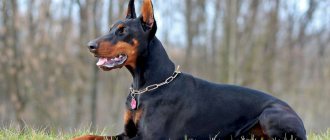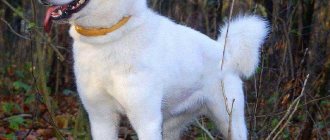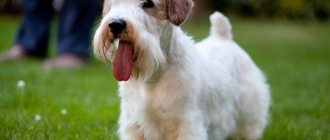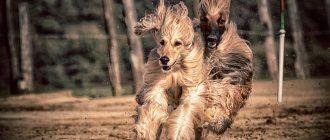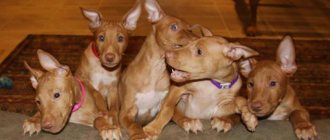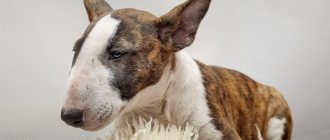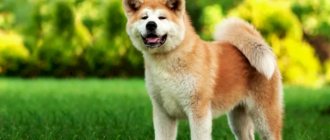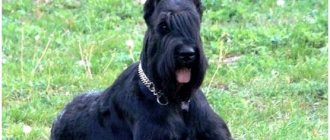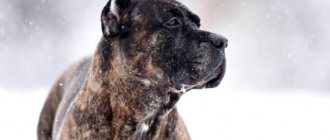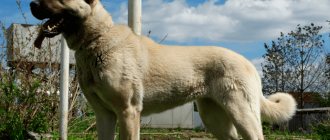The difficulty with these dogs lies in the problems with their upbringing. Some countries do not even allow keeping a Presa Canario dog, since if not raised correctly and during certain situations, these dogs can be extremely dangerous and capable of causing harm.
History of the breed
The Dogo Canario is considered one of the oldest dog breeds. The whole history of this breed is connected with the history of the Canary Islands. This is not an artificially bred breed, but by crossing the local Mahorero breed and imported Molossians. It was used as a herding dog, for guarding the territory and in most cases in entertainment events (dog fights). After the ban on dog fighting on the island, Dogo Canarios were on the verge of extinction. Because people no longer needed them. The breed received official recognition only in 2001.
Dogo Canarios are completely banned in Australia and New Zealand. Cases of dog attacks on people, including fatalities, have been reported.
Spanish Bulldog or Alano Espanol
Alano from Alano Espanol Kennel
The oldest breed from the Molosser group. The ancestors of Spanish bulldogs came to the Iberian Peninsula in the 5th century along with the Alano tribe. During their formation, the breed became famous as military combat dogs and hunting hunting dogs. Fierce, strong animals with powerful jaws and a death grip accompanied the conquistadors on aggressive campaigns and drove bulls for bullfights.
Alano are excellent guards, hunters and companions, who organically combine self-confidence, innate intelligence, and nobility. They form strong bonds with their family and are patient with children.
Spanish bulldogs were registered in Russia in 2015, and there is a national Alano club. The breed is under consideration by the FCI.
Character of the Dogo Canario
- Fearless
- strong-willed
- Dominant
- Confident
- Calm
- Not trusting of strangers
If you are not a leader by nature, are not strong in spirit and do not have physical strength, then the dog is not for you. The dog has a strong character and the owner must understand this.
What conditions make up a dog's character? It is widely believed that the character of a four-legged pet is determined at the genetic level. Also, many people close to cynology argue that character traits are nothing more than the consequences of training and daily upbringing of a puppy. The conditions under which the pet is kept also play an important role. You should not expect your pet to be sociable and friendly towards people if he has been shouted at since childhood, waved at with a leash, or with a newspaper.
Experienced dog breeders will certainly say that if you want to achieve mutual understanding with your own pet, then you must match in temperament and in some character traits. To correctly choose the breed that suits you, first study this issue theoretically: consider the exterior of the dogs you like, read the breed standard, pay attention to the description of the temperament and characteristics of the breed's behavior, ask questions to the real owners of the breed you are interested in. If, in theory, you are satisfied with the breed of your future pet, go to a nursery, or to people engaged in private breeding. A competent breeder who cares about his breed will readily respond to your requests for help in selecting a puppy. It is difficult to say with certainty what kind of character your chosen dog will grow up to be in such a short period of time. There are several simple tests with which you can choose a little friend with the qualities you need.
Care and maintenance
- Bath as needed during the warm season.
- The wool is combed out with a special mitten.
- Dogo Canarios are smooth-haired, so they require an insulated kennel/enclosure.
Basic rules for caring for a dog
- Dental care. It is enough to examine the Dogo Canario's teeth and oral cavity once a week. As for the care itself, during a thorough examination you should pay attention to: The condition of the gums - if they are red and inflamed, it is recommended to contact a veterinarian who will recommend special medications or remedies;
- Teeth color – ideally, it should remain normal, without plaque (you can clean it yourself) and purulent formations. To maintain teeth in good condition, special bones and toothpastes for dogs can be very useful;
- Dental health – check for loose or broken teeth. Between them there should also be no food residues, the accumulation of which causes the animal to develop an unpleasant odor from the mouth and subsequently rot;
- The presence of tartar - in this case, it is impossible to do without the intervention of a veterinarian and its removal. It should also be noted that an important factor for the health of the Dogo Canary - and in particular the teeth - is proper balanced nutrition.
Remember that all dog grooming procedures help to establish a relationship with the dog and train him to be disciplined. Regular checking of the Dogo Canario puppy will develop into a kind of obligatory and pleasant communication procedure. If you notice any changes in behavior or find any unexplained sores or redness, contact your veterinarian.
Diet
Canarians need a balanced diet, which can consist of both natural and dry food. When choosing the latter, it is important to remember that cheap types can negatively affect the pet’s health, while the animal’s kidneys begin to suffer, and oncology may gradually develop. If you decide to accustom your canario to natural food, you should also use high-quality products. A natural menu should consist of 50% meat. Acceptable products are:
- chicken;
- offal;
- turkey;
- beef.
The rest of the diet is vegetables and cereals. Once or twice a week, meat should be replaced with fish/seafood. Fermented milk products are beneficial for your pet, especially puppies up to one year old, when their skeletal system is actively developing, need them. Canarians should also be given boiled eggs and fresh greens. If possible, the breed should be offered young nettles. It is necessary to protect your pet from smoked meats and sweets. Water should always be freely available.
Health
Dogo Canarios are fairly healthy dogs. But like everyone else, they are susceptible to the following diseases:
- hip dysplasia;
- elbow dysplasia;
- various forms of allergies;
- epilepsy;
- skin diseases.
Preventative measures to protect your Dogo Canario puppy
- To keep your Dogo Canario puppy completely safe, you first need to minimize his contact with unfamiliar dogs, especially strays. Therefore, you should not let your dog off the leash, as in this case it will become impossible to control its behavior and communication with other dogs. Since a dog can easily become infected with distemper from simply touching the nose of a sick animal. This disease can be transmitted to a dog through sniffing. Your dog can become infected with trichophytosis from contact with the lichen-affected fur of a sick dog. Naturally, it is impossible to completely exclude a dog’s communication with other dogs, since it must be socialized. Therefore, try to find friends with dog lovers who look after their animals. By adhering to this rule, you can eliminate the risk of pathogen transmission by 80%.
- You should walk your dog in places where there are no landfills. Since garbage very often attracts rodents, which in turn are very often carriers of various infections. Gray rats are especially dangerous because they carry such a serious disease as leptospirosis.
- You should not allow your dog to sniff other people's feces, as they are a source of worms.
- Monitor the health of your Dogo Canario. Pay attention to even the most minor changes in his behavior. For example, your dog may appear lethargic, lose his appetite, or have a dry nose. Or you may notice that the dog begins to shed, and this has nothing to do with seasonal shedding. If hair loss becomes excessive, this is the first symptom indicating health problems in your pet. And only you can help him. Therefore, it is important to take the dog to the veterinary clinic in time, where the disease can be overcome for sure. In no case should you ignore the symptoms, since advanced infections are much more difficult to treat, and sometimes even impossible. If you start treating your dog, the disease can lead to his death or he will develop serious complications that will affect his hearing, vision, limbs and much more.
Characteristics of Dogo Canario
At first glance, the dog makes an impressive impression: stately, massive, with powerful jaws and a calm look, you can see a real fighter in him. Long guard and shepherd service only confirms this. Most representatives of the Canary dog imagine it as an aggressive, angry, unbalanced animal, however, if you raise the Canario correctly and socialize it from an early age, you will get a friendly and devoted companion.
Exterior
The Spanish Dogo belongs to the group of medium Molossians. The height of an adult dog reaches 65 cm, in exceptional cases it can fluctuate in one direction or another by 2 cm. Minimum weight is 50 kg, body length is greater than height. This trait is clearly manifested in bitches that have a long body. Canario is similar in appearance to his brothers – the Great Dane and the Great Dane.
The head of the Great Dane is massive, cube-shaped and has loose skin, with the muzzle taking up about 40% of the head. The muzzle is wide at the base, tapering slightly towards the nose. A dog's bite can be straight or scissor-shaped; the first is considered a disadvantage, since in such animals the teeth wear out faster. The canario's neck is strong, muscular, slightly shorter than the length of the head. The folds hanging down in its lower part form a suspension.
- You Can't Call Yourself a Driver If You Don't Know These 9 Secrets
- Surprisingly, these 15 things are draining your energy and vitality.
- 17 foods to lower blood cholesterol levels
The dog's body is wide, with slightly pronounced barrels. The dog's back is flat, the muscles on it are well developed, but not very noticeable. The croup has a rounded shape, wide and not very long, since this would make it difficult for the dog to walk, limiting its mobility. The Dogo Canario's ribs are noticeably arched, the chest is wide and muscular. The canario's tail is thick at the base and tapers noticeably towards the end. In the raised position, it has a saber shape and does not bend or twist.
The movements of the canario are elastic, the steps are long, thanks to which the dogs quickly cover significant distances. The color of Great Danes from the island of Tenerife in Spain is brindle, but can vary, and the following shades are found:
- dark (brown, chocolate);
- redheads;
- light gray.
Standard
The appearance of Canary dogs combines power and grandeur, and thanks to the brindle color, some exoticism is added to these qualities. The body standards of the Perro de Presa Canario are as follows:
- Frame. It has straight contours, the ratio of length to height should be approximately 4:5. Thus, the dog’s body is almost square, due to which the body has good stability. A massive chest, straight back with a slight slope towards the croup further improve this characteristic.
- Scull. Small but very massive. The ears are medium in size, set far apart, the eyes are oval and proportional.
- Limbs. Muscular, straight, proportionally built. The Dogo Canario's shoulders must have the correct slope. The hind legs are slightly longer and parallel.
- Wool. The brindle color is more common, but fawn, red, and black silver shades are occasionally found. Canarios have short hair without undercoat.
- Tail. Thick at the base, tapering towards the end. Should not fall below the hock joint.
Training and education
Be sure to take the OKD course! Contact specialists. They are well trained, but they test their owner all the time and show stubbornness and independence. You need to be firm and persistent. Start training from the age of three months and correct behavior, and not wait 6-8 months and then hastily teach the command “no”, “come to me” and so on.
Submitting a dog doesn't always work. The principle of complete submission of the Dogo Canario to the owner is an outdated method. This theory was formulated based on observations of packs of wild wolves, but they were kept in captivity and, of course, experienced stress. The stress condition forced wolves to show aggression towards each other, but in the wild they do not show aggression to each other - they live together and interact with each other. You need to perceive yourself as the more experienced and mature member of the pack, who is responsible for guiding the new member (Dogo Canario puppy) and teaching him good behavior, as well as correcting him if necessary. It is important to remember that Dogo Canario puppies learn a lot on their own. They are very inquisitive, love to explore new territories and, of course, experiment. Puppies tend to repeat actions they enjoy (like playing with a toy). They do not repeat actions that cause them pain (for example, destroying a nest and getting bitten). If your Dogo Canario puppy misbehaves, ignore him and praise him when he does the right thing. Reward your puppy for following commands and good behavior. Do not neglect these tips. After all, constantly hearing “you can’t” all day long is unbearable. This is a small child who wants to know everything and get his portion of treats as a reward for not eating your favorite rug, going to the toilet outside, bringing you a ball, and so on.
Set rules and monitor their implementation
It's worth enrolling your Dogo Canario puppy in obedience training classes. These classes will allow you to understand exactly what actions will allow you to control your dog’s behavior. You will be able to spend more time with your puppy, establish contact and socialize around other dogs.
Adviсe
- Training a Dogo Canary puppy should be done with the help of positive motivation; watch carefully special films about this technique. The Canine Translator film series from National Geographic is suitable.
- If you need to leave your puppy at home alone for 2 hours or more, then ask someone to come to him.
- Be sure to schedule your Dogo Canario puppy an appointment with the veterinarian as soon as possible. The doctor will carefully examine him and give him vaccinations that will protect him from dangerous diseases.
Attitude towards children and pets
Aggression towards other dogs . There are often individuals that are very aggressive towards other dogs. It is not recommended to have same-sex dogs or other dogs (especially small breeds). If this happens, then it is necessary to keep them separately; together they can only be under your control.
This breed of dog is not a nanny. The child can be with the dog and play only under your supervision. The dog is not the first to attack, but having a strong character, it will not tolerate pranks on the part of the child.
Where to buy a Dogo Canario puppy?
A specialized kennel is the best place to buy a good Dogo Canario puppy. If pedigree and thoroughbred are important, then it is better to hire an experienced dog breeder to help. If not, then you can trust your heart. On nursery websites, there are customer reviews that will help you navigate. A little secret or life hack: visit a dog show where the desired breed will be presented. Chat with the owners of the breed, ask about the nuances, find out where they purchased the puppies. True dog breeders live for their pets, so they will be happy to answer any question and give valuable advice. Typically, nurseries send their representatives to exhibitions, where there is a chance to meet in person and take a business card.
How to choose a strong and healthy Dogo Canario puppy
The day has come to go to the nursery for a cute puppy. Babies should be kept in a clean enclosure, without a specific unpleasant odor, which is very important. First of all, the breeder will demonstrate the numerous awards that his pets have received. Listen carefully, but don’t be easily fooled by all the big titles and championship accolades. If possible, you need to look at the parents of the future pet. The main 10 signs that will help you choose a healthy Dogo Canario puppy:
- shiny and moist nose;
- clean ears, pink;
- lively, clear look;
- clean eyes, without any discharge;
- healthy skin, without parasites, sores and acne;
- silky, shiny coat;
- lymph nodes of normal size;
- tail without creases;
- no bloating.
A good proof that the animal is healthy is a written document of purchase and sale. If the Dogo Canario puppy develops abnormalities over time, according to the contract, the pet can be returned. Having “insurance” with the buyer will reduce the risk that the seller will slip in a problem animal.
Age for adoption
- Professional Russian dog breeders advise buying 8-10 week old puppies. At this age, the baby should already be vaccinated, toilet trained, and receive basic education.
- An important point: it is not recommended to take a puppy home immediately after separation from its mother. Until 9 weeks of age, the baby learns dog language and learns to communicate with its own kind. He needs to spend several weeks in a doggy daycare.
- A professional breeder knows that a Dogo Canario puppy that is less than 6 weeks old cannot be given away. A very small puppy can only be given to an experienced owner who knows how to raise it correctly. This option is not suitable for a beginner.
- Depending on the breed, the puppy can be picked up earlier or later than 10 weeks of age. Large dogs grow more slowly, so it is recommended to remove them from kennels at the age of 3 months. Puppies of such breeds should gradually build up bone and muscle tissue, without sudden jumps, in order to avoid problems with the musculoskeletal system.
- For Dogo Canario puppies of show or breeding class, the age of “adoption” can only be 6-9 months. This is a mandatory condition, because it is at this age that the makings of a champion and the distinctive signs of thoroughbred are revealed. You need to have patience to get a future titled champion.
Note : even the most expensive Dogo Canario puppy cannot with a 100% guarantee become a champion. The breeder’s job is to assess the potential and make a forecast. Next, you need to raise the puppy and train it for a long time in order to realize the makings of a champion.
Documentation
- A Dogo Canario puppy has a mark in the groin area or it may be on the ear, as well as a puppy card (metric). The codes on the card and on the stamp must be identical.
- Metrica is the primary document that is issued for a puppy when it reaches the age of 45 days. Next, a qualified dog handler examines the babies and notes any defects found. The owner of the dog, if desired, can change the metric to a new document, pedigree, at the age of 6-15 months. This document will allow the pet to participate in breeding.
- Another document for the puppy is a veterinary passport, with mandatory vaccination and deworming notes.
Interesting facts about the Dogo Canario
- “Preso canario” is translated from Spanish as “a dog that strangles/grabs.”
- The breed is banned in many countries: Australia, New Zealand and Malaysia.
- Until now, the breed exists in various types, which are very difficult to fit into the official FCI standard. Because of this, questions may arise when choosing a puppy.
If you decide to get a dog, then get ready for the following: you will often have to clean up little mistakes after your puppy; investments will be required in annual vaccinations, feeding, toys, ammunition, etc.; any animal requires attention and communication, so if you don’t have time, then there will be no mutual understanding with the Dogo Canario puppy. Big changes are coming in your life. If you can handle this, you will find a loyal friend for life. Training and education of the Dogo Canario
Dogo Canario Raising a dog is about developing correct behavior. This is the basis for successful training. Training is a set of activities... Read more
Dogo Canario color
Dogo Canario Color is a canine term that refers to the color of a dog's coat. It is one of the most important signs when ... Read more
The character of the Dogo Canario: who is better to take a bitch or a dog
Dogo Canario The character of a dog depends on heredity and breed characteristics, but proper education and training is also of no small importance. In… Read more
Diseases of the Dogo Canario
Dogo Canario Each breed of dog has a predisposition to certain diseases. We have collected information about typical diseases of the breed. Remember the symptoms of the disease, ... Read more
Dogo Canario
Description
A large dog, with a muscular and strong body. Males at the withers reach 58-66 cm, weight from 45 to 65 kg. Bitches are from 56 to 64 cm at the withers, weigh from 39 to 55 kg.
The head is massive, wide, square, brachycephalic type. The correct head shape is part of the breed standard and a distinctive feature of its best representatives.
Traditionally, ears are cropped in order to reduce the number of vulnerable spots in dogs and to give it a more severe expression.
In this case, the ears stand straight, but in many countries it is prohibited to crop the ears. In this case, the shape of the ears is hanging, in the form of a rose.
The upper lip hangs down, when viewed from the front, the shape of the upper and lower lip forms an inverted V. The inside of the lip is dark in color.

